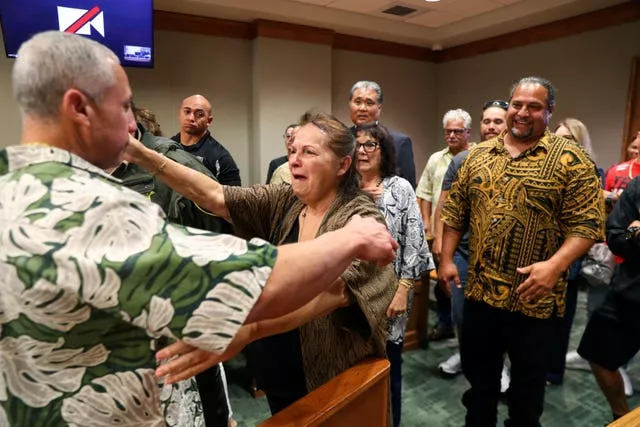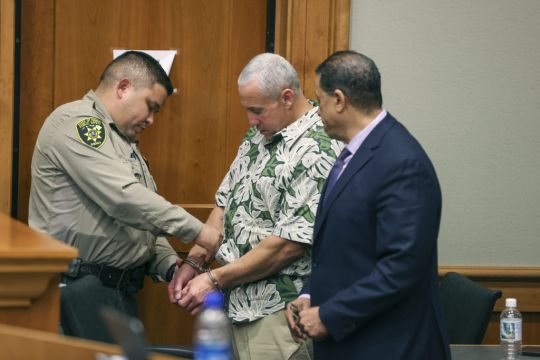A man jailed for kidnapping, sexually assaulting and murdering a woman visiting Hawaii has been released after more than 20 years after his lawyers presented new evidence and said he is innocent.
Albert ‘Ian’ Schweitzer, who was convicted in 2000 – the year after the killing – and sentenced to 130 years in prison, should be “released from his shackles immediately”, judge Peter Kubota ruled.
That prompted applause in the Hilo courtroom and hugs for Mr Schweitzer, who was flown to the Big Island for the hearing from the Arizona prison where he was serving his sentence.
“My feelings were all over the place,” Mr Schweitzer said about the moment of his release.
“Nerves, anxiety, scared.”

The justice system is “flawed”, he said, calling himself one of many imprisoned for crimes they did not commit. He earlier told reporters he is “grateful” the judge did the “honourable thing”.
A petition filed late on Monday outlined additional evidence in one of Hawaii’s biggest murders, which unfolded on Christmas Eve in 1991 on the Big Island.
Dana Ireland, 23, was found barely alive in bushes along a fishing trail in Puna, a remote section of the island. She had been sexually assaulted and beaten and later died at Hilo Medical Centre.
The mangled bicycle she had been riding was found several miles away and appeared to have been hit by a vehicle.
The murder of the blonde-haired, blue-eyed visitor from Virginia gained national attention and remained unsolved for years, putting intense pressure on police to find the killer.
“Whenever you have a white, female victim … it gets a lot more attention than people of colour and Native Hawaiians,” said Kenneth Lawson, co-director of the Hawaii Innocence Project.

“The parents, understandably, were becoming more and more infuriated. … There was insurmountable pressure to solve this case. And when that happens, mistakes are made. Some intentional and some unintentional.”
Ms Ireland’s relatives could not immediately be reached for comment on the petition and Mr Schweitzer’s release. Prosecutors did not immediately comment on Mr Schweitzer’s release.
With help from the Innocence Project in New York, the co-counsel in the case, Mr Lawson’s group represented Mr Schweitzer, the last of three Native Hawaiian men convicted over Ms Ireland’s death still in prison.
DNA evidence previously submitted in the case belonged to an unknown man and all three convicted men were excluded as sources.
New DNA evidence, according to the petition, shows a Jimmy Z brand T-shirt found near Ms Ireland and soaked with her blood belonged to the same unknown man and not one of the three men, as prosecutors claimed.
New tyre tread analysis also concluded Mr Schweitzer’s Volkswagen Beetle car did not leave the tyre marks at either location where Ms Ireland and her bike were found.

A forensic odontologist also concluded an injury on her left breast was not a bite mark as previously believed, the petition said.
“At a new trial today, a jury would not convict Mr Schweitzer of Ms Ireland’s sexual assault and murder,” the petition said.
“In fact, a prosecutor would likely not even arrest Mr Schweitzer for this crime.”
The likelihood all three men participated in a sexual attack and left no trace of biological evidence — including a lack of evidence uncovered with advanced forensic testing — is “extraordinarily improbable”, the petition said.
In 2019, Mr Schweitzer’s lawyers and Hawaii County prosecutors entered into a “conviction integrity agreement” to reinvestigate the case.
It was the first time in Hawaii there has been this type of agreement, Mr Lawson said, which is increasingly being used to reexamine questionable convictions and guard against future errors.

“Over the last three years, we have shared information and re-examined forensic evidence. No matter the outcome in these post-conviction proceedings, we remain committed to identifying unknown male number one and seeking justice for Dana Ireland and her `ohana,” Hawaii County prosecuting attorney Kelden Waltjen said in a statement before the ruling, using the Hawaiian word for family.
However, deputy prosecuting attorney Shannon Kagawa asked the judge to deny the petition, saying the new evidence would not change the outcome of a new trial.
Mr Kubota disagreed, saying that based on the new evidence, a jury would acquit Mr Schweitzer.
Much of the background on the case is detailed in a document filed with the petition listing facts defence lawyers and prosecutors have stipulated.
In 1994, police made what they believed to be a major breakthrough.
A man facing charges for his role in a cocaine conspiracy contacted police and claimed his half-brother, Frank Pauline Jnr, witnessed the attack on Ms Ireland, according to the stipulated facts document.

Police interviewed Pauline Jnr, who was in his third month of a 10-year sentence for an unrelated sexual assault and theft.
He claimed brothers Ian and Shawn Schweitzer attacked and killed Ms Ireland. But he was interviewed at least seven times and gave inconsistent accounts each time, eventually incriminating himself, the stipulation document said.
Despite a lack of evidence linking them to the killing, the two Schweitzers and Pauline were indicted in 1997.
At one point the charges were dismissed because all three men were excluded as the source of bodily fluid found on Ms Ireland’s body and a hospital bedsheet. They were indicted again after another informant claimed Ian Schweitzer confessed to him in jail that Pauline raped and killed Ms Ireland.
Pauline later said he offered details to police about Ms Ireland’s murder in order to get drug charges dropped against his half-brother.
In a prison interview with the A&E show American Justice, Pauline compared his story to the tale of the boy who cried wolf.

“Wasn’t me,” he said in a strong Hawaii Pidgin accent. But when he started telling the truth, he said no one believed him.
Shawn Schweitzer took a deal to plead guilty to manslaughter and kidnapping — and receive credit for about a year served and five years of probation — after seeing juries convict Pauline and his brother in 2000.
In October, Shawn Schweitzer met with prosecutors and recanted. According to the stipulation document, he pleaded guilty because his “parents did not want to risk losing another son and encouraged Shawn Schweitzer to do what he needed to do to come home and not suffer the same fate as his brother”.
Shawn Schweitzer “continues to feel immense guilt about agreeing to the confession and entering a guilty plea for a crime he did not commit and falsely implicating his brother”, the document said.
A polygraph test in November showed he was telling the truth when he denied any involvement in the murder, the document said.
Pauline was killed in a New Mexico prison by a fellow inmate in 2015.
Being back in Hawaii “tastes great”, Mr Schweitzer said.
“The air is good,” he said. “The water is good.”







